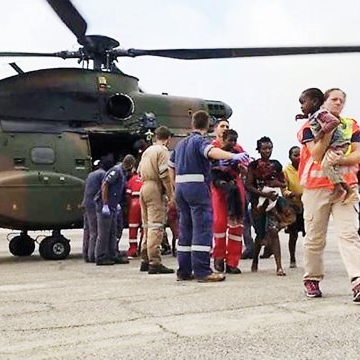
Featured Item

Rescue South Africa: In the eye of the storm
TALI FEINBERG
He and part of his team returned on Sunday from Mozambique, where Cyclone Idai has wreaked a level of devastation that he thinks will take years to repair.
What made him and 14 other emergency professionals leave their home comforts and family, and drive for 33 hours into a natural disaster?
“It’s the blessing of saving lives,” says Scher. “Our motto at Rescue South Africa is, ‘Africans saving Africans’. We want to show that we can help each other on this continent, and don’t always need first-world countries to come in and rescue us.
“After all these years, it is always a blessing to be able to save a life. As a rescuer who is always learning and training, it is great to be successful with these skills.”
Scher, 69, became a volunteer firefighter about 40 years ago, and 20 years ago, he and other volunteers from rescue services decided to start the nongovernment organisation Rescue South Africa. They have been on many rescue missions since then. In between, they train public and private-sector service providers in rescue services.
All 20 people with Scher (five joined later to reinforce their efforts) were volunteers. “We heard that the cyclone was due to hit on the Saturday, so on the Tuesday, we started putting the mission together. We built a team, and in 22 hours we were on the road. We drove for three days, and were the first rescue organisation at the scene in Beira, Mozambique.”
The cyclone had already hit. Scher’s team spent that Friday evening clearing and cutting trees and pylons that had blocked the road to the airport. He and his team set up camp in the airport departure lounge, which was a luxury compared to the camps he has set up in the past. The airport was inoperable and temporarily closed.
The next day, some of the team dived into the raging rivers while others, using inflatable boats, rescued about 22 people. After that, they could use only helicopters with rescuers hanging down from “long lines” to grab people perched on trees, roofs, and high land.
They rescued hundreds of people this way, but had to prioritise children, the elderly, and women. “It’s very tough for the team to make these kinds of choices. In spite of that, it was one of our most successful missions. I’ve seen a lot of death and devastation, but at least here we saw people who were alive. Our early response allowed us to help hundreds.”
But, at the end of the day, these volunteers are not superhuman, and helicopters cannot fly at night. “One night, we had to stop the rescue because darkness had fallen, but we knew people were still out there. The next day, the water had risen even higher, meaning those people might have drowned.” These are the harrowing realities of life as a rescuer.
Scher says he did not see many bodies, but that does not mean they were not there – washed away or under water. “This is a disaster of great magnitude,” he emphasises. It will be compounded by thousands in displaced-person’s camps, humidity, a lack of electricity or running water, and the spread of disease.
“It was so hot. Even though there was so much rain, it did not cool you down. With dead bodies and waste in the water, it is perfectly primed for the spread of disease,” he says. Indeed, reports are now coming in of the first cases of cholera in the area.
Scher says one of the greatest challenges of this mission was a lack of communication. Because of the storm, cell phones and even satellite phones were inoperable. “It’s very hard to deal with such a situation if you can’t communicate. But the secret of disaster services is being able to think on your feet and find alternatives.”
For example, the road that his team drove in on was washed away, and the only way to reach the area now is by plane or boat. Eventually, he managed to fly back to South Africa with the South African Airforce from the very airport where he had set up camp. Some members of his team remained there for the rest of this week.
“The acute recovery phase is over, now the recuperation begins. Most people have lost everything. There is no sign of where they lived. In such a flat country, the water just spreads. But some on higher ground have started to rebuild.” The map of the area has changed, with new inland lakes appearing on satellite images.
Ultimately, the people at Rescue South Africa do this work because of a passion for humanity, according to Scher. “At some point in life, we hopefully get to make a choice about how we will contribute towards the wider community, and for me it began with becoming a volunteer firefighter – living out a childhood dream.”
Through Rescue South Africa, Scher is involved in building capacity in the Southern African Development Community (SADC) region.
For those who want to help the people affected by this natural disaster, he suggests making financial donations, as goods and food are a logistical challenge.
He points out that the cyclone affected our northern neighbour, Zimbabwe, showing just how close to home it really was.
As the water recedes, the true extent of the disaster will be revealed. Meanwhile, his colleagues remain on the ground, trying to rescue any remaining survivors.




